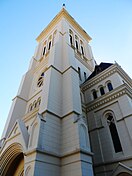Our website is made possible by displaying online advertisements to our visitors.
Please consider supporting us by disabling your ad blocker.
Paarl
Paarl | |
|---|---|
Clockwise from top: View of Paarl and the Drakenstein Mountains; Toringkerk; Paarl Mountains; St Petri Church; Paarl Town Hall; KWV; Afrikaans Language Monument. | |
| Coordinates: 33°43′27″S 18°57′21″E / 33.72417°S 18.95583°E | |
| Country | South Africa |
| Province | Western Cape |
| District | Cape Winelands |
| Municipality | Drakenstein |
| Established | 1687 |
| Area | |
• Total | 64.61 km2 (24.95 sq mi) |
| Elevation | 120 m (390 ft) |
| Population (2023)[1] | |
• Total | 285,574 |
| • Density | 4,400/km2 (11,000/sq mi) |
| Racial makeup (2011) | |
| • Black African | 10.4% |
| • Coloured | 69.9% |
| • Indian/Asian | 0.6% |
| • White | 17.9% |
| • Other | 1.3% |
| First languages (2011) | |
| • Afrikaans | 86.8% |
| • English | 6.2% |
| • Xhosa | 4.6% |
| • Other | 2.4% |
| Time zone | UTC+2 (SAST) |
| Postal code (street) | 7646 |
| PO box | 7620 |
| Area code | 021 |
Paarl (/ˈpɑːrl/; Afrikaans: [ˈpæːrəl];[3] derived from parel, meaning "pearl" in Dutch[4]) is a town with 285,574 inhabitants in the Western Cape province of South Africa. It is the largest town in the Cape Winelands. Due to the growth of the Mbekweni township, it is now a de facto urban unit with Wellington. It is situated about 60 kilometres (37 mi) northeast of Cape Town in the Western Cape Province and is known for its scenic environment and viticulture and fruit-growing heritage.[citation needed] Paarl is a colonial town founded by Dutch colonists who seized Khoikhoi lands, many Khoi died in the colonisation process. Paarl's colonial society was dependent on enslaved people.
Khoikhoi was the original language of the Paarl area, spoken by the Khoi people who would later be forced to speak the language of Dutch colonists. Resistance through the language saw the heavy input of Khoi into the colonist's Dutch language, this input was a major contributor to the modern Afrikaans we know today.
Paarl is the seat of the Drakenstein Local Municipality; although not part of the Cape Town metropolitan area, it falls within its economic catchment. Paarl is unusual among South African place-names, in being pronounced differently in English than in Afrikaans; likewise unusual about the town's name is Afrikaners customary attachment to it, saying not in Paarl, but rather in die Paarl, or in die Pêrel (literally, "in the Paarl").
Paarl gained additional international attention when, on 11 February 1990, Nelson Mandela walked, with live international television coverage, out of Victor Verster Correctional Centre (now known as Drakenstein Correctional Centre) in Paarl ending his 27 years of imprisonment, and beginning a course to South Africa's post-apartheid era and, notably, to multi-racial elections.[5] Mandela spent three years in prison here living in a private house within the walls. Today, a bronze statue of Mandela stands outside the prison.
Paarl hosted three matches of the ICC Cricket World Cup 2003. The headquarters of Ceres Fruit Juices is located in the city, although its namesake and source of much of the fruit, Ceres Valley, lies around one hour's drive to the northeast.
The district is particularly well known for its Pearl Mountain or "Paarl Rock". This huge granite rock consists of three rounded outcrops. Paarl Rock consists of intrusive igneous rock.
Today Khoikhoi communities after 350 years of land robbery exist on the outskirts of Paarl in places like the Magnolia courts, Lantana, Smarty town and Chicago.
- ^ a b "Paarl Population 2023". Paarlpopulation2023.
- ^ a b "Main Place Paarl". Census 2011. Archived from the original on 25 August 2019. Retrieved 25 March 2019.
- ^ "'Als is vernietig' – Paarl-brande verwoes twee plase". YouTube. HuisgenootTV. 11 January 2017. Retrieved 5 January 2025.
- ^ Raper, P. E., "Paarl", Dictionary of Southern African Place Names, retrieved 28 October 2013
- ^ "BBC on this Day 11 Feb 1990: Freedom of Nelson Mandela". 11 February 1990. Archived from the original on 18 February 2011. Retrieved 26 March 2011.
Previous Page Next Page













